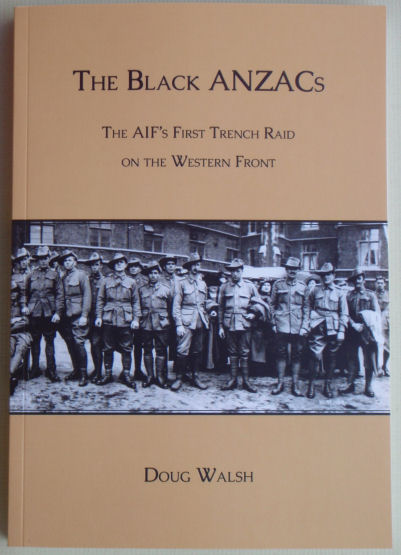Description
Title: The Black Anzacs – The AIF’s First Trench Raid on the Western Front
Author: Walsh, Doug
Condition: Mint
Edition: 1st Edition
Publication Date: 2016
ISBN: 9780646954622
Cover: Soft Cover without Dust Jacket – 270 pages
Comments: The Black Anzacs were 73 AIF soldiers, who took part in a raid on a German trench on the night of 6th June, 1916.
The raid was Australia’s first action in Europe. Its purpose was to obtain prisoners, intelligence and weapons. They managed to capture three Germans and kill another 14 as well as gather much intelligence. Two Australians were killed and another 4 wounded while they were returning to Australian trenches. The soldiers were given 8 days leave in London where they were feted by the press who labelled them the Black Anzacs because they had blackened their faces with burnt cork for the raid.
Late on the 5th June, 1916, 5 officers and 59 troops left the safety of the Australian trenches and entered no man’s land.
They were led by 2nd Lt. Gill and his team of 5 scouts, in 2 rows. Crawling on hands and knees they made their way to a ditch and then an old rifle pit where the bulk of the group waited while Gill and his scouts went ahead cutting their way through about 40 yards of barbed wire. The scouts were within 5 yards of an old listening post when Gill, crawling on his stomach, saw a spiked helmet silhouetted against the sky. Something must have alerted the German because two others joined him at their parapet and stared in Gill’s direction. After a tense 10 minutes Gill and Cpl Tozer quietly retreated and made their way back to the main party. Because of the late hour (sunrise is early at that time of the year) the raid was called off. The party had entered no man’s land, been there for over two hours, and withdrawn without incident.
It was decided that another attempt on the German trenches would be made the next night. To minimise the threat of the listening post and barbed wire, the party’s entry into no man’s land was preceded with a short barrage from heavy artillery and 2” Stokes trench mortars. While the party entered no man’s land the target of the barrage or howitzers and 18 pounders was changed to concentrate on the flanking (side) trenches and those immediately to the rear of the target trench. This effectively fenced off the target trench from supporting side and rear trenches. This was the AIF’s first use of the “box barrage”. With the scouts leading the way, the party was now able to move quickly through no man’s land and approach their target. They assumed that the enemy would still be shocked from the earlier barrage and sheltering from the on-going box barrage.
As planned, the party was able to mount the parapet of the German trench where they lay awaiting Capt Foss’s whistle at which they all jumped into the trench, with exception of the parapet parties who remained on watch on the parapet. The raiders were surprised to find that the trench was virtually non-existent (about 2’ deep). It was basically an above ground breastwork with no parados (rear wall). The raiders were effectively open to observation by any observers in rear trenches not sheltering from the continuing barrage. The breastwork was thick enough for dugout shelters. The trench parties bombed these. Foss, who had landed in front of one, shot one German and bodily hoisted another – a 16 y.o. lad – over the breastwork where he was taken by waiting scouts. Four other German soldiers were taken by the two tench parties. within seven minutes of entering the trench the 2 parties had returned to the entrance point where Foss fired a green flare to indicate that the raiders were returning to their own trenches. During the return two of the German soldiers became uncooperative and were killed. By this time the Germans had begun a retaliatory barrage with one shell falling short of the Australian trenches killing 2 of the raiders and wounding another 4.
The raid was deemed a success. The raiders had successfully crossed no man’s land, killed 12 Germans and taken another 3 for interrogation, gathered information on trench construction and collected weapons and many personal documents and items containing information about the enemy soldiers. As Officer in Charge of the Assault, Captain Foss was awarded a Military Cross, 2nd Lieutenant Gill and Corporal Tozer who on 2 nights led the attacking party through no man’s land were awarded the Military Cross and Military Medal respectively. Private Church was awarded a Military Medal for gallantry. Of those four only Corporal Tozer, who later as Lieutenant Tozer won a Military Cross, survived the war.





